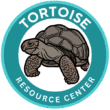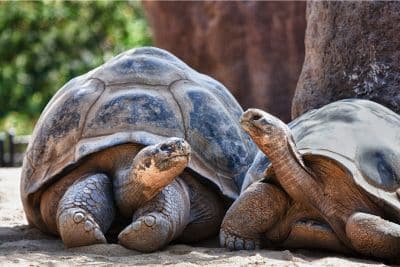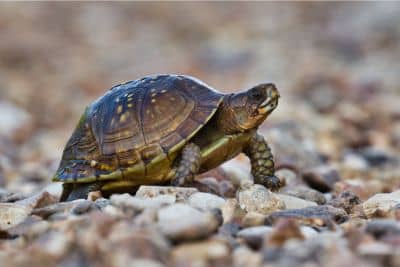One of the most challenging aspects of tortoise care is providing your pet with sufficient space. Many tortoises reach impressive sizes and need incredibly spacious enclosures. This not only means that you may have to build your pet’s enclosure from scratch, but it may also force you to maintain your tortoise outdoors, whether you want to or not.
However, there are a few tortoise species that are relatively small – some are even called “dwarf tortoise” species by tortoise enthusiasts. These tortoises are often much easier to house than their larger cousins, and that typically makes them easier pets to care for.
In this article, I’ll share details of some of the most popular dwarf tortoise species, but first, allow me to define the term “dwarf” in the context of tortoises.
- What Is a Dwarf Tortoise
- 16 Dwarf Tortoise Species
- 1. Speckled Padloper Tortoise (Chersobius signatus)
- 2. Nama padloper (Chersobius solus)
- 3. Karoo Padloper (Chersobius boulengeri)
- 4. Common Padloper (Homopus areolatus)
- 5. Greater Padloper (Homopus femoralis)
- 6. Speke’s Hinge-Back Tortoise (Kinixys spekii)
- 7. Lobatse Hinge-Back Tortoise (Kinixys lobatsiana)
- 8. Natal Hinge-Back Tortoise (Kinixys natalensis)
- 9. Pancake Tortoise (Malacochersus tornieri)
- 10. Geometric Tortoise (Psammobates geometricus)
- 11. Serrated Tent Tortoise (Psammobates oculifer)
- 12. African Tent Tortoise (Psammobates tentorius)
- 13. Spider Tortoise (Pyxis arachnoides)
- 14. Flat-Backed Spider Tortoise (Pyxis planicauda)
- 15. Hermann’s Tortoise (Testudo hermanni)
- 16. Egyptian Tortoise (Testudo kleinmanni)
- Honourable Mention: Three Other Relatively Small Tortoises
- Dwarf Tortoises for Beginners
- Be Mindful of the Law
What Is a Dwarf Tortoise
There is no official definition for the term “dwarf” with respect to tortoises. Typically, it’s simply a term some keepers apply to tortoise species that typically remain small.
But that begs the question, how small is small?
That’s a subjective question with no clear answer. Some keepers may consider 8-inch-long tortoises to be relatively small and therefore deserving of the dwarf label. But other keepers may consider 8-inch-long tortoises to fall into the mid-sized range, and instead decide that the dwarf label is best reserved for tortoises who only reach 4, 5, or 6 inches in length.
I’ll avoid making a declarative statement in this regard – that would only represent my subjective opinion on the matter. However, most would likely agree that tortoises who reach lengths in excess of about 8 inches are too large to qualify as a dwarf species by any reasonable definition of the term.
So, I’ll simply share a list of the tortoise species who reliably remain less than 8 inches long and allow the reader to decide which ones are most deserving of the dwarf tortoise label.
16 Dwarf Tortoise Species
I’ve assembled 16 of the smallest tortoise species below. These species generally grow to sizes ranging from 3 to 8 inches in length, though it is important to note that individual variation is common in all tortoise species, and you may end up acquiring an animal that slightly exceeds the listed size range.
It is also important to recognize that some of these species are represented by more than one subspecies. And in some cases, the different subspecies reach different sizes.
1. Speckled Padloper Tortoise (Chersobius signatus)
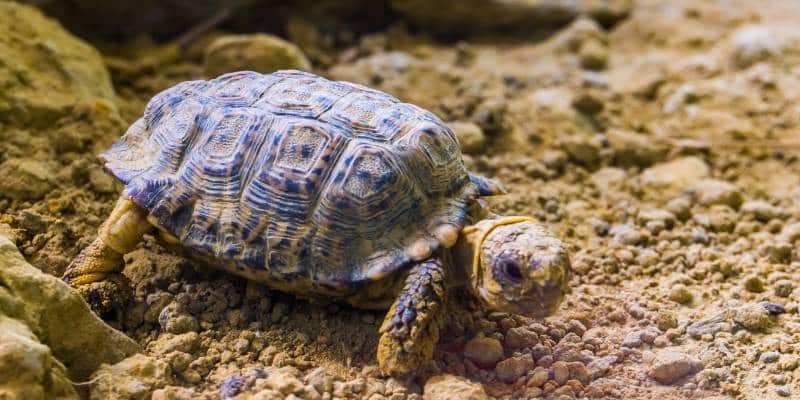
Typically recognized as the world’s smallest tortoise species, speckled padlopers usually reach about 3.5 inches in length (although some females may grow slightly larger).
While considered easier to maintain than Karoo padlopers and occasionally offered for sale, these tortoises don’t make good pets for beginners. They have unusual annual activity patterns and are dietary specialists, who’re sometimes difficult to feed.
2. Nama padloper (Chersobius solus)
Another species that rarely reaches 4 inches in length, the Nama padloper is a Namibian species, who specializes in eating some of the region’s plants. Accordingly, they do not make good captives, as they rarely adapt to the kinds of foods offered in captivity. Additionally, this species is rarely available to purchase.
3. Karoo Padloper (Chersobius boulengeri)
Sometimes called Boulenger’s cape tortoise, the Karoo padloper is a small tortoise species that inhabits the Nama Karoo region of South Africa.
A very small tortoise, most individuals remain less than 4 inches in length and weigh less than 6 ounces. These tortoises are reportedly difficult to feed, making them a poor choice for novice tortoise enthusiasts. For that matter, they’re rarely offered for sale on the legal pet market.
4. Common Padloper (Homopus areolatus)
While the common padloper grows slightly larger than some other padloper tortoises, it is still a very small animal, which rarely exceeds 4.25 inches in length.
A South African native, this tortoise does adapt reasonably well to captivity, as it has a more varied natural diet than some of the other padloper tortoises. Nevertheless, it is rarely offered for sale. And even when it is, it typically commands astronomical prices, which put it out of reach for most beginning tortoise keepers.
Are You Starving Your Tortoise?
Save 10% on premium tortoise food and supplements from Tortoise Resource Center on Amazon now using code BUYNOWGET10
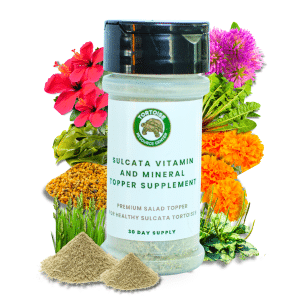
Sulcata Vitamin & Mineral Topper Supplement
30-Day Supply | 2 oz (56 g)
$24.99
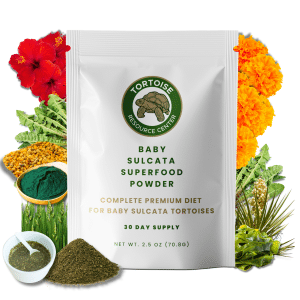
Baby Sulcata Tortoise Superfood Powder
30-Day Supply | 2.5 oz (70.8 g) Bag
$24.99
5. Greater Padloper (Homopus femoralis)
Despite being the largest padloper species, greater padlopers rarely reach more than 4 or 5 inches in length. They tend to inhabit rocky areas in South Africa, and they are another padloper species that is a dietary specialist. This, combined with their rarity, means they aren’t commonly maintained in captivity.
6. Speke’s Hinge-Back Tortoise (Kinixys spekii)
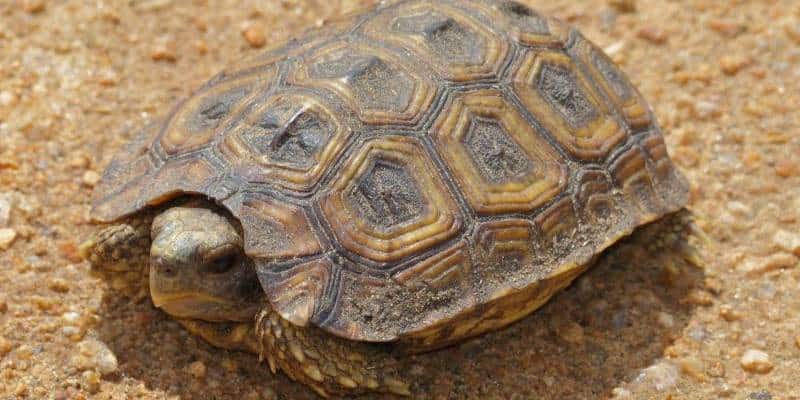
While Speke’s hinge-back tortoises reach larger sizes than some other hinge-back tortoises, they generally top out at less than 8 inches in length. As with most other hinge-back tortoises, they likely make good pets, but they’re just not offered for sale very often.
7. Lobatse Hinge-Back Tortoise (Kinixys lobatsiana)
One of the smallest hinge-back tortoise species, the Lobatse hinge-back tortoise reaches about 6 or 7 inches in length. Like all other hinge-back tortoises, they’re capable of closing their shells via their namesake shell hinge. They can make good pets, but they just aren’t commonly offered for sale.
8. Natal Hinge-Back Tortoise (Kinixys natalensis)
Likely the smallest of the hinge-back tortoises, the Natal hinge-back tortoise is generally less than 6 inches in length. Another small species that hails from Africa, these tortoises can make suitable pets for beginning tortoise keepers. The problem is they aren’t often offered for sale or available in the pet trade.
9. Pancake Tortoise (Malacochersus tornieri)
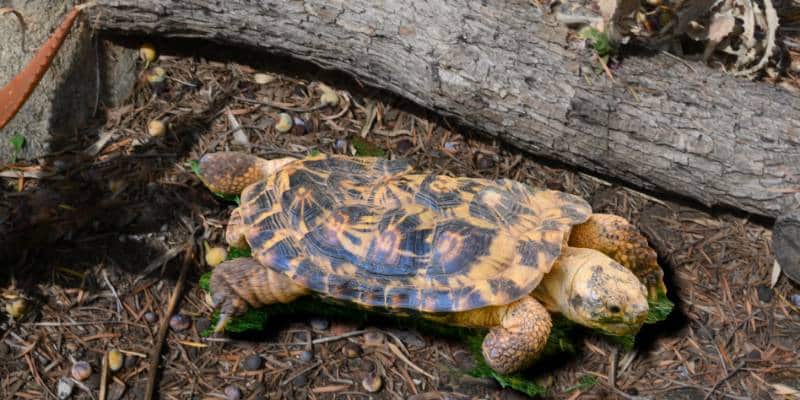
Although pancake tortoises may reach about 7 inches in length, most are in the 6-inch range. They’re also fairly light tortoises, who top out at around 1 pound. Part of the reason they’re so light is that their skeletons feature gaps. This, combined with their unusual, flattened shape, makes them more agile than many other tortoise species.
While they aren’t considered an especially easy species to care for, they’re certainly not as challenging to maintain as some of the other species discussed here. Additionally, they’re typically not hard to find on the market, though they’re often relatively expensive.
10. Geometric Tortoise (Psammobates geometricus)
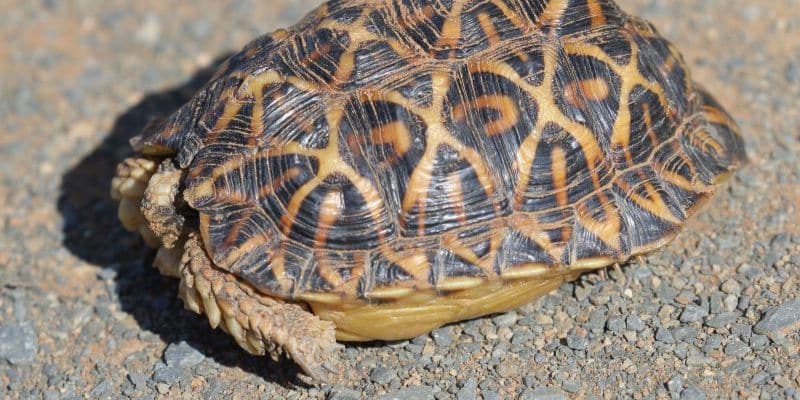
These attractive tortoises resemble ornate box turtles (Terrapene ornata) in many respects, but they hail from Africa instead of North America. Considered the rarest living tortoise species by some, they aren’t often offered for sale and international trade of the species is prohibited.
11. Serrated Tent Tortoise (Psammobates oculifer)
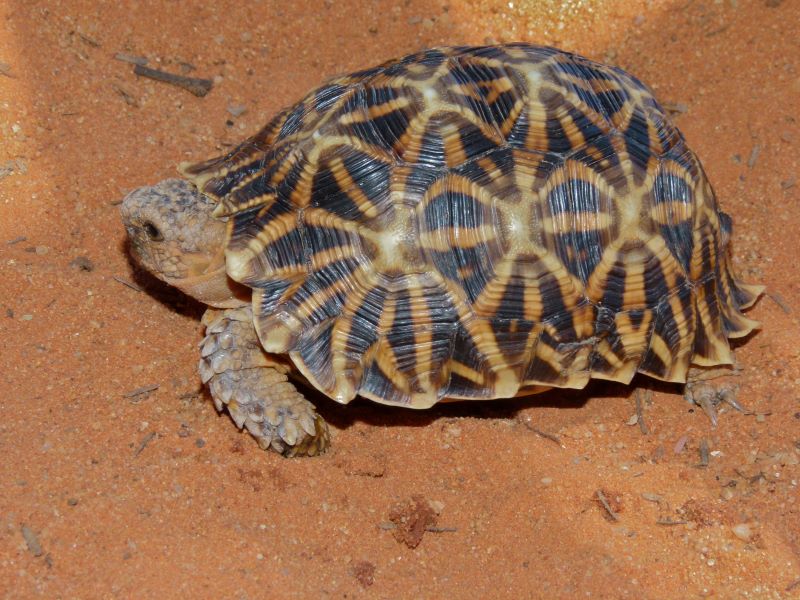
Typically only reaching 5 to 6 inches in length, these attractive tortoises derive their name from the jagged shell margin they possess. Note that several other tortoise species are sometimes called serrated tortoises, so it is important to be clear about species identifications (this illustrates yet another reason why it is important to learn the scientific names of animals you are interested in). Nevertheless, these tortoises are not commonly offered for sale.
12. African Tent Tortoise (Psammobates tentorius)
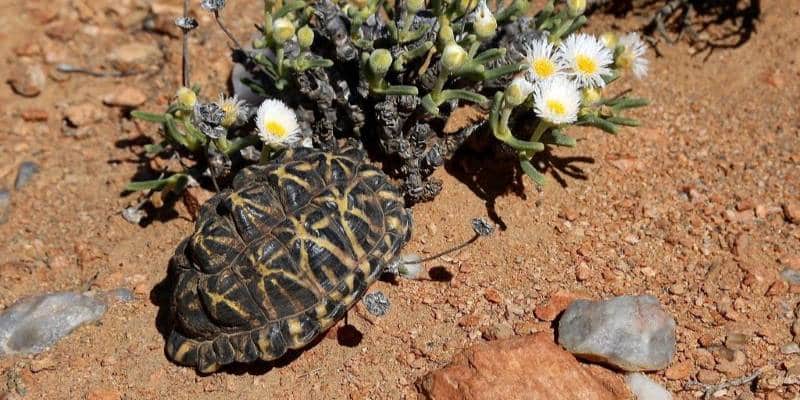
Yet another small-but-largely-unavailable species hailing from southern Africa, the African tent tortoise is a very attractively marked species. But they don’t make good captives, as they have a specialized diet, which is hard to replicate in captivity.
13. Spider Tortoise (Pyxis arachnoides)
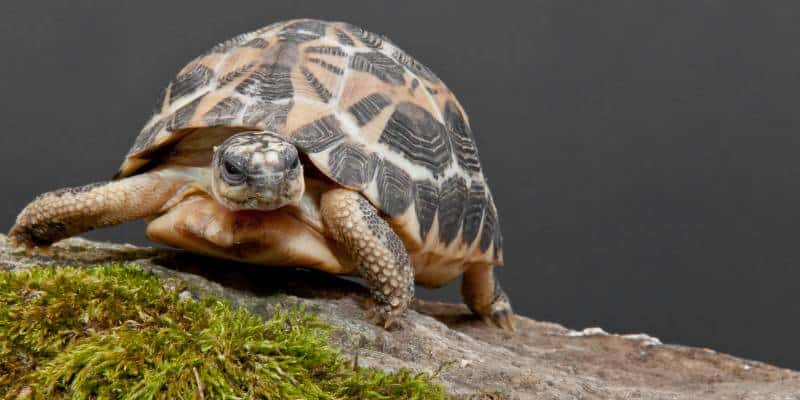
Spider tortoises are generally pretty small, with most individuals measuring less than 7 inches in length. They can be reasonably easy to care for, though they do require a long brumation period each year.
The primary obstacle beginning keepers will face with this species is their rarity. These tortoises have a very slow reproductive rate and produce single-egg clutches. This means there are simply not many available, and those that are offered for sale typically command high prices.
14. Flat-Backed Spider Tortoise (Pyxis planicauda)
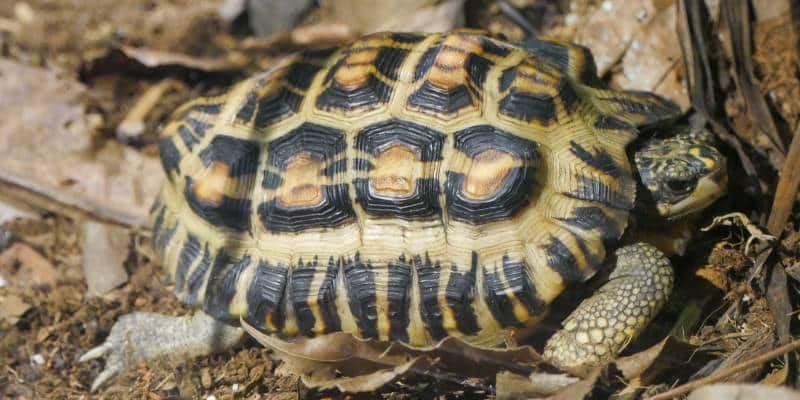
Close relatives of spider tortoises, flat-backed spider tortoises reach about 7 inches in length. They’re also from Madagascar, but their wild populations are under great threat. They are not commonly seen in the pet trade, though they may make suitable captives for some keepers.
15. Hermann’s Tortoise (Testudo hermanni)
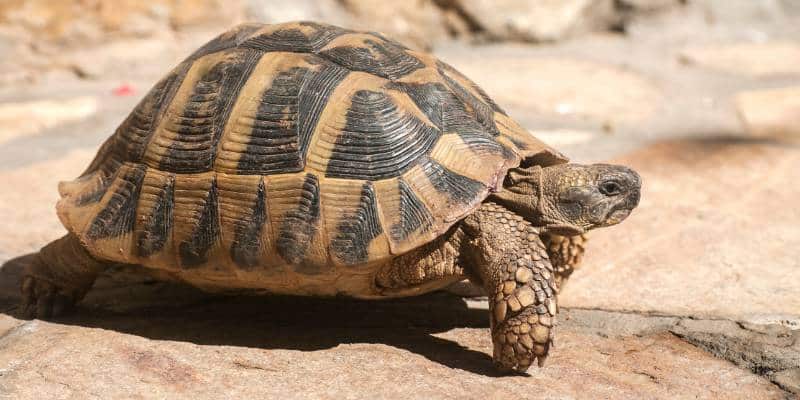
There are two species of Hermann’s tortoises – the eastern Hermann’s tortoise (T. h. hermanni) and the western Hermann’s tortoise (T. h. boettgeri). While the eastern Hermann’s tortoise certainly doesn’t grow as large as some other tortoise species, it does occasionally reach 11 inches in length. By comparison, the eastern Hermann’s tortoise rarely exceeds 8 inches in length.
Eastern Hermann’s tortoises typically make good pets, and they’re among the best dwarf tortoises for novice keepers to maintain.
16. Egyptian Tortoise (Testudo kleinmanni)
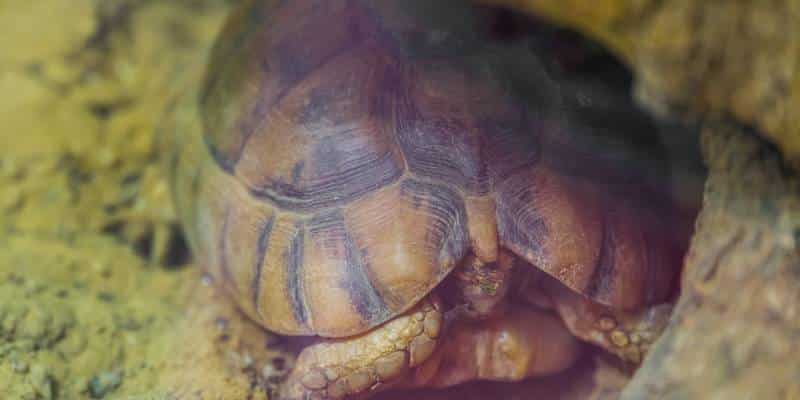
Endearing little tortoises, Egyptian tortoises are usually less than 6 inches long. Unlike some of the other dwarf tortoises detailed here, Egyptian tortoises are often fairly easy to maintain, as they don’t present any unusual care requirements. They’re also readily available in the pet trade, though they command very high prices.
Honourable Mention: Three Other Relatively Small Tortoises
There are three other tortoises, which are also small, yet may occasionally exceed the 8-inch threshold I’ve already mentioned. Nevertheless, some keepers may find them small enough to deserve consideration.
Angulated Tortoise (Chersina angulata)
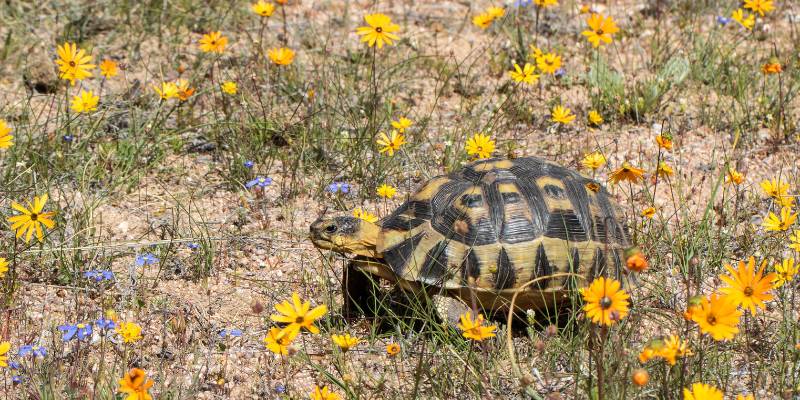
Sometimes called the bowsprit tortoise (a reference to the long plastral projections of the gular area in males), these tortoises can make good pets, but the males are capable of reaching 10 inches in length. Though they’re closely related to padlopers, they do not tend to present the same feeding challenges padlopers do. These tortoises are occasionally offered for sale, but they typically fetch high prices.
Russian Tortoise (Testudo horsfieldii)
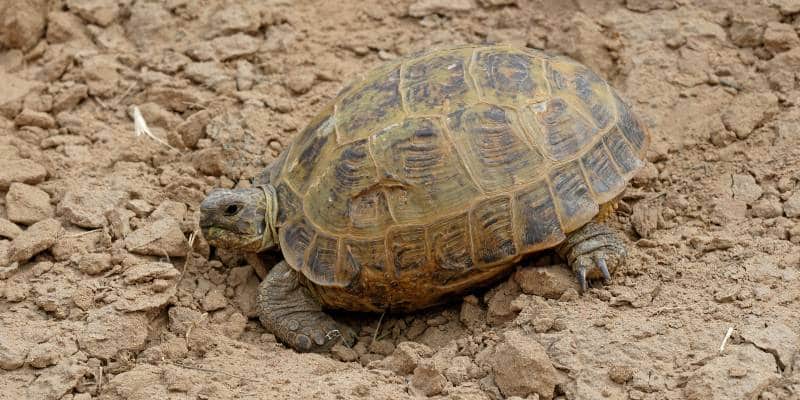
Likely one of the best species for beginning tortoise keepers on this list, the Russian tortoise often makes a delightful captive. They’re generally personable, easy to feed, readily available, and affordable. However, most specimens offered for sale are wild-caught, which can lead to health problems. When possible, opt for captive-bred individuals instead.
However, while most Russian tortoises are in the 4-to-6-inch size range, some do reach 10 inches in length.
Bell’s Hinge-Back Tortoise (Kinixys belliana)
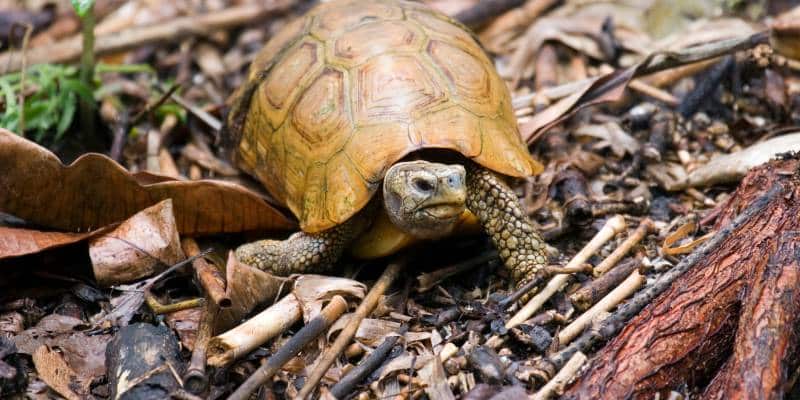
Many Bell’s hinge-back tortoises will likely fall into the arbitrarily defined dwarf category I’ve established above, but some individuals do exceed 8 inches in length. In any event, these tortoises are typically easy to house and often make good pets for beginners. However, it is wise to opt for captive-bred rather than wild-caught individuals whenever possible.
Dwarf Tortoises for Beginners
Given that many of the dwarf species discussed above are not available in the legal pet trade, and others present significant husbandry challenges, it can be tricky for beginners to know which species would make the best pet.
While it is difficult to identify the best species for all situations and keepers, the following are some of the best options for beginning tortoise keepers who want a relatively small pet:
- Egyptian tortoise
- Western Hermann’s tortoise
- Russian tortoise
- Bell’s hinge-back tortoise
- Pancake tortoise
- Angulated tortoise
Be Mindful of the Law
It’s important to remember that U.S. law prohibits the sale of turtles and tortoises with shell lengths of less than 4 inches except for bona fide scientific or educational purposes.
This law is commonly broken, as you can find small turtles and tortoises offered for sale at reptile expos every weekend. But that doesn’t mean you couldn’t find yourself in hot legal water, should you break it.
This is especially relevant for most tortoise breeders, as no tortoise species produce hatchlings that regularly exceed 4 inches in length. Even Galapagos tortoise (Chelonoidis niger) hatchlings rarely measure 4 inches in length; small species are often less than 2 inches when they hatch. Accordingly, the hatchlings must typically be kept for some length of time before they’re offered for sale.
This isn’t always a huge problem — Galapagos tortoises, Aldabra tortoises (Aldabrachelys gigantea), sulcata tortoises (Centrochelys sulcata), and other large species may be capable of reaching 4 inches in length within a year or two. But many dwarf tortoise species barely exceed 4 inches in length upon reaching maturity. This means that it may take them several years to become large enough to legally sell.
So, if you intend to breed small tortoise species, be sure that you are prepared to maintain the hatchlings for several years, while they grow large enough to be legal to sell.
Citations
- Animal Diversity Web – Chersina angulate
- Tortoise Trust – Care and Maintenance of common South African tortoises; A Brief Summary
- All Turtles – 6 Turtles That Stay Small
